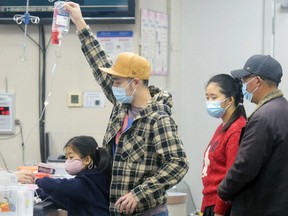Metapneumovirus causes many of the same symptoms as COVID 19 such as a bad cough, fever and a possible lung infection.

If you’ve been seeing new headlines about a virus in China, there’s no cause for concern.
Recommended Videos
China has had a steady rise this season in cases of human metapneumovirus (HMPV), a long-standing but little-known pathogen that has been identified as a main cause of respiratory illness and hospitalizations this winter.
For most people, symptoms will be mild, but it can also cause a lung infection, severe cough, sore throat and fever, much like COVID-19. In past seasons, when HMPV has spiked, the cases have been among children, seniors and those with weak immune systems.
Although HMPV can make people very sick, the current situation is “very different” from the COVID-19 pandemic which was completely new to humans, said Jill Carr, a professor and virologist at Flinders’ University’s college of medicine and public health.
The Chinese Centres for Disease Control and Prevention say that country’s current winter illness season remains less severe than last year.
Here’s what to know about the human metapneumovirus.
What is human metapneumovirus?
HMPV is a respiratory syncytial virus and most people who are infected experience mild symptoms similar to a cold, according to the U.S. Centers for Disease Control and Prevention. The symptoms last a week, and go away without treatment in healthy individuals. More serious cases can lead to lung infection and severe cough. The CDC says it’s spread through close contact, coughing and sneezing, and is more common in winter and spring.
It can cause upper and lower respiratory disease in people of all ages, especially young children, older adults and those with weakened immune systems.
HMPV is in the Pneumoviridae family along with respiratory syncytial virus (RSV), and was discovered in 2001, according to the B.C. CDC.
Symptoms include cough, fever, nasal congestion and shortness of breath. Clinical symptoms can progress to bronchitis or pneumonia.
Why am I suddenly seeing more stories about HMPV?
The new attention on HMPV — just one among a host of germs that causes the common cold — is likely due to improved virus detection capabilities in China and other countries after the COVID pandemic, during which governments spent billions on testing infrastructure and companies raced to develop better virus detection kits.
And five years after COVID sent the world into lockdown, outbreaks of illness in China attract outsized attention and are often the subject of misleading social media posts.
Is HMPV easy to detect or to test for?
HMPV, first discovered in the Netherlands in 2001, has become far easier to detect and is among a suite of respiratory pathogens that commonly used testing kits now screen for.
Lab testing for pathogens including HMPV used to take a long time, with results often confirmed long after a patient had recovered.
“Testing these days can identify the virus causing infections within half an hour, so patients will quickly find out and that’ll trigger more learning and attention,” Hu Yang, a physician at Shanghai Pulmonary Hospital, told the National Business Daily last month.
Is HMPV being detected around the world?
While not a new virus, HMPV appears to also be vexing governments across the region, with India, Malaysia and Hong Kong reporting cases in recent days.
Indonesia and Vietnam said they are closely monitoring the HMPV situation in China, and are asking the public not to panic.
Are there cases of it in B. C.?
Postmedia has reached out to the B.C. Centre for Disease Control for updated 2024/2025 figures. We’ll update this section when we learn more.
The positivity rate in early spring was about 10 per cent and has since declined to below five per cent as of Thursday. The agency said the rates are much lower than COVID.
How do I treat it?
Currently, there’s no vaccine for HMPV or antiviral drugs, so doctors focus on treating the patients’ symptoms. The B.C. centre says people can help prevent the spread of the virus by washing hands, and avoiding contact with people who are sick.
What should people do if they think they have it?
People who have cold-like symptoms should practise respiratory etiquette (coughing and sneezing into a tissue or your elbow) and wash their hands frequently and properly. They’re asked to stay home from work or school, not to share cups and utensils, and to refrain from kissing.
Those who have difficulty breathing or a severe cough that won’t go away should see a doctor.
With files from Bloomberg.